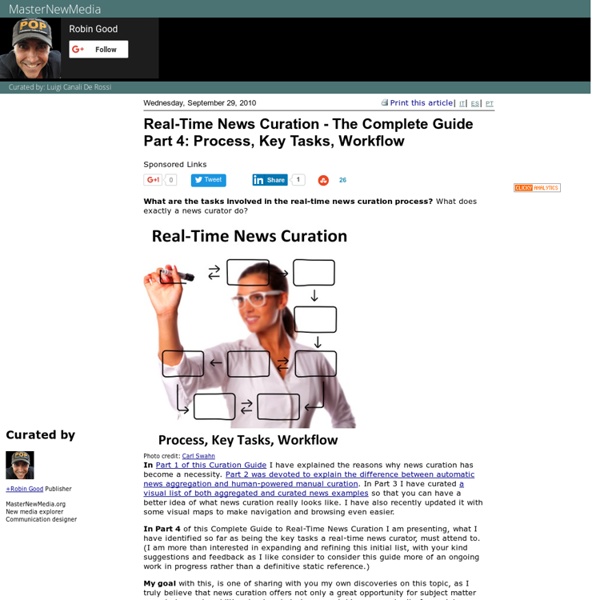Content Curation: Beyond the Institutional Repository and Library Archives - Personal Knowledge Management for Academia & Librarians
If you are an academic librarian, you have been hearing about Data Curation, Content Curation, Information Curation or Digital Curation for years. And the terms can be applied in several different ways. There are the curation activities surrounding purchased library materials and the curation of faculty and student items (like theses and dissertations for example).
SocialCompare - Comparisons community
Collaborative comparison engine Register Sign in Sign in Sign out 's dashboard Curation Platforms
Digital Content Curation Is Career for Librarians
By John Farrier A cherpumple is a cherry pie, a pumpkin pie, and an apple pie each baked within separate cakes, then assembled and iced. I found a picture of one on a food blog, posted it on Neatorama.com, and from there the cherpumple went viral.
The 5 Models Of Content Curation
Curation has always been an underrated form of creation. The Getty Center in Los Angeles is one of the most frequently visited museums in America – and started as a private art collection from one man (J. Paul Getty) who had a passion for art. Aside from a few well known examples like this one, however, the term curation has rarely been used outside of the world of art … until now. One of the hottest trends in social media right now is content curation – thanks in no small part to the leading efforts of several thought leaders actively promoting the idea. Joe Pulizzi is a “content marketing evangelist” who speaks and writes often about content marketing publishes a list of the best content marketing blogs across the web.
Content Curation : An Essence of New-Age Digital Marketing
With the instant availability of meaningful content, videos on You Tube, millions of blog scrolls and other informational gateways, organizations are finding the need for content curators in social media. Content curation is the method of locating, organizing and sharing online content. Frankly, we need curators to go through the lofty task of wading through endless scrolls of information until they find the hidden gems.
SEO-Friendly Content Curation
by Virginia Nussey, April 29, 2013 If you're a brand online, today's conversational media world requires you're also a publisher if you have any hope of holding space in the public marketplace. Yet the requirements of publishing are a tall order for most brands. Today's savvy audience has high standards for content deemed worthwhile and sharable.
The Content Strategist as Digital Curator
The term “curate” is the interactive world’s new buzzword. During content creation and governance discussions, client pitches and creative brainstorms, I’ve watched this word gain traction at almost warp speed. As a transplant from museums and libraries into interactive media, I can’t help but ask what is it about this word that deserves redefinition for the web?
The Difference Between Content Curation and Link Spraying
"Content curation" is one of those phrases that gets repeated ad nauseam without much thought into what it actually means or what role it should play in our digital marketing strategies. It is a term that that is widely used, yet the definition of content curation (at least in the social media marketing sense) is murky and unspecific. This blog post is an attempt to define what digital content curation is and how we can begin to think more creatively about this throwaway term. I don't think it means what you think it means
Content Curation and the Interest Graph: Delivering Context to the Consumer
In December, an article I wrote "Content Is King, But Distribution Is Queen and She Wears the Pants" was nominated and won an end-of-the-year contest for the best content marketing post of 2013. The contest was run by a new startup called ShareBloc, a new content distribution platform for professionals to share and curate content. The original post identified the growing problem of content saturation on the Internet.
Museums and the Web 2010: Papers: Miller, E. and D. Wood, Recollection: Building Communities for Distributed Curation and Data Sharing
Background The National Digital Information Infrastructure and Preservation Program at the Library of Congress is an initiative to develop a national strategy to collect, archive and preserve the burgeoning amounts of digital content for current and future generations. It is based on an understanding that digital stewardship on a national scale depends on active cooperation between communities. The NDIIPP network of partners have collected a diverse array of digital content, including social science data-sets; geospatial information; Web sites and blogs; e-journals; audiovisual materials; and digital government records ( These diverse collections are held in the dispersed repositories and archival systems of over 130 partner institutions where each organization collects, manages, and stores at-risk digital content according to what is most suitable for the industry or domain that it serves. Specific goals for the Recollection project are to:
What’s the law around aggregating news online? A Harvard Law report on the risks and the best practices
[So much of the web is built around aggregation — gathering together interesting and useful things from around the Internet and presenting them in new ways to an audience. It’s the foundation of blogging and social media. But it’s also the subject of much legal debate, particularly among the news organizations whose material is often what’s being gathered and presented. Kimberley Isbell of our friends the Citizen Media Law Project has assembled a terrific white paper on the current state of the law surrounding aggregation — what courts have approved, what they haven’t, and where the (many) grey areas still remain. This should be required reading for anyone interested in where aggregation and linking are headed.


